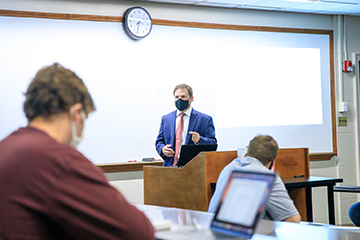
Nearly a decade ago, Samford University set a vision—to cultivate a culture of collaboration across its faculty, equipping them with the skills and confidence to embrace new technology and teaching methods to engage students at a deeper level.
Online education has long been a modality used by Samford faculty, especially at the graduate level, but in recent years, initiatives like the Faculty Success Collaborative and the leadership provided by the Office of Academic Affairs, have pushed faculty to utilize technology more, embracing innovation at all levels.
Yet, in spring of 2020, this forward momentum was put to the ultimate test.
In March, universities across the country moved to online instruction due to COVID-19, and Samford faculty were forced to adapt—and fast. Thankfully, the seeds that had previously been planted had already begun to take root. Through quick thinking, a collegiate spirit and the focus always on students, Samford faculty found ways to persevere through an academic year like no other, renewing their commitment to creativity, innovation and collaboration.
A Quick Response
At the onset of the pandemic, the pivot from in-person courses to online instruction happened extraordinarily fast. The university made the announcement on Wednesday, March 11, and faculty resumed their courses online the following Monday.
“We adapted quickly and effectively during the initial shut down and many worked over the summer to make in-person instruction possible last fall and this spring,” said Rusty Yerkes, associate professor in Samford’s Brock School of Business. “I find most students and faculty appreciative of the extensive efforts to make this happen.”
Even as courses resumed in person last fall and this spring, these efforts did not end. Faculty continued to adapt and modify their courses, responding to student feedback. “We have seen that a pandemic cannot defeat ingenuity, hard work and God’s spirit displayed through the actions of so many,” Yerkes said.
A Collegiate Spirit
In support of this ingenuity and hard work, faculty experienced a general collegiate spirit among their colleagues across campus. While the pandemic forced some professors to teach online for the first time, the majority of faculty had previous experience—understanding the technology and unique pedagogy. Through avenues like the Faculty Success Collaborative and the Continuity of Instruction Task Force, they had regular opportunities to collaborate across disciplines, sharing their experiences and helping provide support and resources.
“The best thing that we did as a university was work together to achieve the common goal of giving our students the best education possible under difficult circumstances. Everyone cooperated in achieving that common goal,” said John Carroll, professor in Samford’s Cumberland School of Law.
A Focus on Students
This goal of engaging and educating students always remained at the forefront of faculty’s work, ultimately seeking ways to improve and expand the opportunities they could offer. “The lessons we have learned and the technology we have utilized—it just enables us to make the student experience even better,” said Mike Hardin, provost of Samford University. “Technology is just another tool in the instructor’s tool chest; it’s our job to help [faculty] know how to use it better.”
According to Hardin, the faculty’s deep commitment to collaboration, especially in times such as these, only produces benefits for students—as it challenges faculty to set a high bar for themselves and for others.
“We adapted. And by ‘we’ I mean students and employees alike. I believe that most people would say this is the hardest they’ve ever worked in their lives both physically and mentally and that the hard work made us feel alive and creative,” said Dana Basinger, assistant dean in Samford’s Howard College of Arts and Sciences.
“We will never, ever forget the students and colleagues from the 2020-2021 school year. We pulled together through the suffering and the hard work and we realized we had to trust and count on each other to survive. In essence, the university revealed what it is at its best—a community who unites around a common goal of seeking truth and lifting each other up,” Basinger added.
